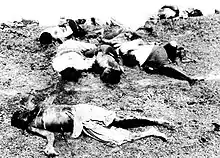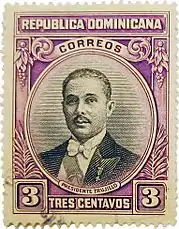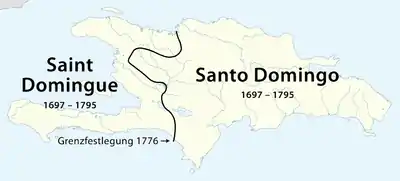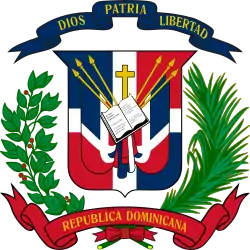Parsley massacre
The parsley massacre (Spanish: el corte "the cutting";[11] Creole: kout kouto-a "the stabbing"[12]) (French: Massacre du Persil; Spanish: Masacre del Perejil; Haitian Creole: Masak nan Pèsil) was a mass killing of Haitians living in the Dominican Republic's northwestern frontier and in certain parts of the contiguous Cibao region in October 1937. Dominican Army troops came from different areas of the country[13](p161) and carried out the massacre on the orders of Dominican dictator Rafael Trujillo. As a result of the massacre, virtually the entire Haitian population in the Dominican frontier was either killed or forced to flee across the border.[14]
| Parsley massacre | |
|---|---|
 Haitians murdered in the parsley massacre | |
| Location | Dominican Republic |
| Date | 2 October 1937 – 8 October 1937 |
| Target | Haitians in the Dominican Republic |
Attack type | Massacre, genocide[1][2][3][4][5][6] |
| Weapons | Krag rifles, machetes and bayonets |
| Deaths | 12,168–35,000[7][8][9][10] |
| Perpetrators | Dominican Army |
| Motive | Anti-black racism, Antihaitianismo |
Background

Dominican dictator Rafael Trujillo, a strong proponent of anti-Haitianism, regarded Haitians as a racially and culturally inferior people. He saw Haitian migration as a detriment to the social and economic development of the Dominican nation.
There is no feeling of humanity, nor political reason, nor any circumstantial convenience that can force us to look indifferently at the Haitian migration. That type is frankly undesirable. Of pure African race, they cannot represent for us any ethnic incentive. Not well nourished and worse dressed, they are weak, though very prolific due to their low living conditions. For that same reason, the Haitian that enters lives afflicted by numerous and capital vices and is necessarily affected by diseases and physiological deficiencies which are endemic at the lowest levels of that society.
On 2 October 1937 Trujillo made his intentions towards the Haitian community clear in a brief speech he gave during a celebration in his honor in the province of Dajabón.
For some months, I have traveled and traversed the border in every sense of the word. I have seen, investigated, and inquired about the needs of the population. To the Dominicans who were complaining of the depredations by Haitians living among them, thefts of cattle, provisions, fruits, etc., and were thus prevented from enjoying in peace the products of their labor, I have responded, 'I will fix this.' And we have already begun to remedy the situation. Three hundred Haitians are now dead in Bánica. This remedy will continue.[16]
Massacre
Trujillo reportedly acted in response to reports of Haitians stealing cattle and crops from Dominican borderland residents. Trujillo commanded his army to kill all Haitians living in the Dominican Republic's northwestern frontier and in certain parts of the contiguous Cibao region. Between October 2 and October 8, hundreds of Dominican troops, who came mostly from other areas of the country, poured into the region.[13](p161) These armed forces killed Haitians with rifles, machetes, shovels, knives, and bayonets. Haitian children were reportedly thrown in the air and caught by soldiers' bayonets, then thrown on their mothers' corpses.[17] Some died while trying to flee to Haiti across the Massacre River that divides the two nations.[18] Survivors who managed to cross the border and return to Haiti told stories of family members being hacked with machetes and strangled by the soldiers, and children bashed against rocks and tree trunks.[19] The use of military units from outside the region was not always enough to expedite soldiers' killings of Haitians. U.S. legation informants reported that many soldiers "confessed that in order to perform such ghastly slaughter they had to get 'blind' drunk."[13](p167) Several months later, a barrage of killings and repatriations of Haitians occurred in the southern frontier.
Lauren Derby claims that a majority of those who died were born in the Dominican Republic and belonged to well-established Haitian communities in the borderlands.[20] However, it is difficult for anyone to ascertain a victim's place of birth, especially considering that, in most cases, their identities are unknown, and their births may not have been officially recorded. Furthermore, Haiti has historically awarded citizenship by Jus sanguinis, making anyone with a Haitian parent a Haitian citizen, whereas from as early as 1929 until 2014, the Dominican Republic followed a restricted Jus soli citizenship policy, which excluded from this privilege illegal residents and anyone not having legal permanent residency status.[21][22]
Contributing factors

Haitian-Dominican relations have long been strained by territorial disputes and competition for the resources of Hispaniola. Between the years of 1910–1930, there was an extensive migration of Haitians to their neighboring countries of Dominican Republic and Cuba in search of work. The exact number of Haitian migration to the Dominican Republic is not readily available but it is more than the estimated 200,000 that emigrated to Cuba. Among several authors, the Haiti-Dominican Republic migration corridor is concurred as far more important than the Haiti-Cuba migration due to geographic proximity. On the other hand, the large influx of Haitians to the Dominican Republic further divided the complicated relationship between the two nations.[23] The Dominican Republic, formerly the Spanish colony of Santo Domingo, is the eastern portion of the island of Hispaniola and occupies five-eighths of the land while having ten million inhabitants.[24] In contrast, Haiti, the former French colony of Saint-Domingue, is on the western three-eighths of the island[25][26] and has almost exactly the same population, with an estimated 200 people per square kilometre.[27]
Population growth led to many Haitians living on land too mountainous, eroded, or dry for productive farming. Instead of staying on lands incapable of supporting them, many Haitians migrated to Dominican soil, where land hunger was low. While Haitians benefited by gaining farm land, Dominicans in the borderlands subsisted mostly on agriculture, and benefited from the ease of exchange of goods with Haitian markets.
Due to inadequate roadways connecting the borderlands to major cities, "Communication with Dominican markets was so limited that the small commercial surplus of the frontier slowly moved toward Haiti."[28] This threatened Trujillo's regime because of long-standing border disputes between the two nations. If large numbers of Haitian immigrants began to occupy the less densely populated Dominican borderlands, the Haitian government might try to make a case for claiming Dominican land. Additionally, loose borders let contraband pass freely, and without taxes between nations, depriving the Dominican Republic of tariff revenue.
Furthermore, the Dominican government saw the loose borderlands as a liability in terms of possible formation of revolutionary groups that could flee across the border with ease, while at the same time amassing weapons and followers.[29]
Repercussions
Despite attempts to blame Dominican civilians, it has been confirmed by U.S. sources that "bullets from Krag rifles were found in Haitian bodies, and only Dominican soldiers had access to this type of rifle."[30] Therefore, the Haitian Massacre, which is still referred to as "el corte" (the cutting) by Dominicans and as kouto-a (the knife) by Haitians, was, "...a calculated action on the part of Dominican dictator Rafael Trujillo to homogenize the furthest stretches of the country in order to bring the region into the social, political and economic fold,"[18] and rid his republic of Haitians.
Thereafter, Trujillo began to develop the borderlands to link them more closely with urban areas.[31] These areas were modernized, with the addition of modern hospitals, schools, political headquarters, military barracks, and housing projects—as well as a highway to connect the borderlands to major cities.
Additionally, after 1937, quotas restricted the number of Haitians permitted to enter the Dominican Republic, and a strict and often discriminatory border policy was enacted. Dominicans continued to deport and kill Haitians in southern frontier regions—as refugees died of exposure, malaria and influenza.[32]
In the end, U.S. president Franklin D. Roosevelt and Haitian president Sténio Vincent sought reparations of $750,000, of which the Dominican government paid $525,000 (US$ 9,336,979.17 in 2019 dollars). Of this 30 dollars per victim, survivors received only 2 cents each, due to corruption in the Haitian bureaucracy.[33]
Condemnation of the massacres was not limited to international sources, as a number of Trujillo's exiled political opponents also publicly spoke out against the events. In November 1937, four anti-Trujillistas were declared "unworthy Dominicans" and "traitors to the Homeland" for their comments—Rafael Brache, José Manuel Jimenes, Juan Isidro Jimenes Grullón, and Buenaventura Sánchez.[34]
Etymology
The popular name[35] for the massacre came from the shibboleth that the dictatorial Trujillo had his soldiers apply to determine whether or not those living on the border were native Afro-Dominicans or immigrant Afro-Haitians. Dominican soldiers would hold up a sprig of parsley to someone and ask what it was. How the person pronounced the Spanish word for parsley (perejil) determined their fate. The Haitian languages, French and Haitian Creole, pronounce the r as a uvular approximant or a voiced velar fricative, respectively so their speakers can have difficulty pronouncing the alveolar tap or the alveolar trill of Spanish, the language of the Dominican Republic. Also, only Spanish but not French or Haitian Creole pronounces the j as the voiceless velar fricative. If they could pronounce it the Spanish way the soldiers considered them Dominican and let them live, but if they pronounced it the French or Creole way they considered them Haitian and executed them.
The term parsley massacre was used frequently in the English-speaking media 75 years after the event, but most scholars recognize that it is a misconception, as research by Lauren Derby shows that the explanation is based more on myth than on personal accounts.[36]
Number of victims
According to some sources, the massacre killed an estimated 20,000 Haitians[37][38] living in the northern frontier—clearly at Trujillo's direct order. However, the exact number is impossible to calculate for many reasons. Among them is the fact that, although the Dominican Army murdered many of the victims in public view, they carried out most of the slayings en masse in isolated areas, leaving either no witnesses or just a few survivors. Another reason why the number of victims is unknown is that an untold but very great number of their bodies ended up either in the sea, where sharks consumed their remains, or in mass graves, where acidic soil degraded them, leaving nothing for forensic investigators to exhume.[39]
Haitian President Élie Lescot put the death toll at 12,168; Haitian historian Jean Price-Mars cited 12,136 deaths and 2,419 injuries. The Dominican Republic's interim Foreign Minister put the number of dead at 17,000. Dominican historian Bernardo Vega estimated as many as 35,000.[7]
See also
References
- Turtis, Richard Lee (August 2002). "A World Destroyed, A Nation Imposed: The 1937 Haitian Massacre in the Dominican Republic". Hispanic American Historical Review. 82 (3): 589–635. doi:10.1215/00182168-82-3-589. S2CID 143872486. Archived from the original on 13 February 2017. Retrieved 26 June 2020.
- Paulino, Edward (Fall 2013). "Bearing Witness to Genocide: The 1937 Haitian Massacre and Border of Lights". Afro-Hispanic Review. 32 (2): 111–118. JSTOR 24585148.
- Garcia, Juan Manuel (1983). La matanza de los haitianos: genocidio de Trujillo, 1937. Editorial Alfa & Omega. pp. 59, 69–71.
- Roorda, Eric Paul (July 1996). "Genocide Next Door: The Good Neighbor Policy, the Trujillo Regime, and the Haitian Massacre of 1937". Diplomatic History. 20 (3): 301–319. doi:10.1111/j.1467-7709.1996.tb00269.x.
- Karczewska, Anna Maria. Reconstructing and (De)constructing Borderlands: The Parsley Massacre: Genocide on the Borderlands of Hispaniola in the Farming of Bones by Edwidge Danticat. pp. 149–165.
- Pena, Julissa. ""Yo soy negro, pero negro blanco:" Hispanicity, Antihaitianism and Genocide in the Dominican Republic". Wesleyan University. Archived from the original on 7 September 2017. Retrieved 26 June 2020.
- Wucker, Michele (8 April 2014). Why the Cocks Fight: Dominicans, Haitians, and the Struggle for Hispaniola. ISBN 9781466867888. Archived from the original on 3 October 2020. Retrieved 13 October 2017.
- Newman, Graeme R (19 October 2010). Crime and Punishment around the World [4 volumes]: [Four Volumes]. ISBN 9780313351341. Archived from the original on 19 April 2019. Retrieved 13 October 2017.
- Tunzelmann, Alex von (13 September 2012). Red Heat: Conspiracy, Murder and the Cold War in the Caribbean. ISBN 9781471114779. Archived from the original on 19 April 2019. Retrieved 13 October 2017.
- Charlot, Marjorie (19 November 2015). Did You Know?: Over One Hundred Facts about Haiti and Her Children. ISBN 9781491776896.
- Wucker, Michele. "The River Massacre: The Real and Imagined Borders of Hispaniola". Windows on Haiti. Archived from the original on 28 September 2007. Retrieved 16 December 2007.
- Lauro Capdevila, La dictature de Trujillo : République dominicaine, 1930–1961, Paris, L'Harmattan, 1998
- Turits, Richard Lee (2004). Foundations of Despotism: Peasants, the Trujillo Regime, and Modernity in Dominican History. Stanford University Press.
- Turtis, 630.
- Law, I.; Tate, S. (19 May 2015). Caribbean Racisms: Connections and Complexities in the Racialization of the Caribbean Region. Springer. ISBN 9781137287281. Archived from the original on 3 October 2020. Retrieved 2 October 2020.
- Turtis, Richard Lee (2002). "A World Destroyed, A Nation Imposed: The 1937 Haitian Massacre in the Dominican Republic". Hispanic American Historical Review. 82 (3): 589–635 [p. 613]. doi:10.1215/00182168-82-3-589. S2CID 143872486.
- Paulino, Edward (16 February 2016). Dividing Hispaniola: The Dominican Republic's Border Campaign against Haiti, 1930-1961. ISBN 9780822981039.
- Turtis, 590.
- Galván, Javier A. (2012). Latin American Dictators of the 20th Century: The Lives and Regimes of 15 Rulers. McFarland. p. 53.
- Derby, Lauren (1994). "Haitians, Magic, and Money: Raza and Society in the Haitian-Dominican Borderlands, 1900 to 1937". Comparative Studies in Society and History. 36 (3): 508. doi:10.1017/S0010417500019216.on line copy Archived 5 May 2014 at the Wayback Machine Derby explains: "This point is important because, by the Dominican constitution, all those born on Dominican soil are Dominican. If this population was primarily migrants, then they were Haitians, thus making it easier to justify their slaughter. However, our findings indicate that they were legally Dominicans, even if culturally defined as Haitians since they were of Haitian origin." (Derby, p.508)
- Tribunal Constitucional. "Sentencia TC/0168/13" (PDF) (in Spanish). Archived from the original (PDF) on 12 August 2015. Retrieved 5 May 2014.
- Rodriguez, Virgilio. "Erroneous objections to the Dominican constitutional ruling on citizenship". Al Jazeera. Archived from the original on 17 December 2013. Retrieved 5 May 2014.
- Jadotte, Evans (May 2009). "International Migration, Remittances and Labour Supply. The Case of the Republic of Haiti" (PDF). Archived (PDF) from the original on 23 October 2019.
- Augelli, John P. (1980). "Nationalization of Dominican Borderlands". Geographical Review. 70 (1): 21. doi:10.2307/214365. JSTOR 214365.
- Dardik, Alan, ed. (2016). Vascular Surgery: A Global Perspective. Springer. p. 341. ISBN 9783319337456. Retrieved 8 May 2017.
- Josh, Jagran, ed. (2016). "Current Affairs November 2016 eBook". p. 93. Retrieved 8 May 2017.
- Augelli, 21.
- Augelli, 24.
- Turtis, 600.
- Peguero, Valentina (2004). The Militarization of Culture in the Dominican Republic: From the Captains General to General Trujillo. Lincoln: University of Nebraska Press. p. 114. ISBN 0803204345.
- Turtis, 623.
- Roorda, Eric Paul (1998). The Dictator Next Door: The Good Neighbor Policy and the Trujillo Regime in the Dominican Republic, 1930–1945. Durham: Duke University Press. p. 132. ISBN 082232234X.
- p.41 – Bell, Madison Smartt (17 July 2008). "A Hidden Haitian World". New York Review of Books. 55 (12).
- Naya Despradel (August 13, 2016), "De Fello Brache a Tom Pérez" Archived 27 February 2017 at the Wayback Machine (in Spanish), El Caribe. Retrieved March 4, 2017.
- The name used by historians and scholars is Haitian massacre of 1937. The expression "parsley massacre" appears nowhere in works published by Trujillo Era scholars such as Jésus de Galindez (1956), Robert D. Crassweller (1966), Eric Paul Roorda (1996), Lauro Capdevila (1998) and Lauren Derby (2009).
- "Hispaniola: Trujillo's Voudou Legacy". Archived from the original on 25 January 2013.
- pg 78 – Robert Pack (editor), Jay Parini (Editor). Introspections. PUB. p. 2222.CS1 maint: extra text: authors list (link)
On 2 October 1937, Trujillo had ordered 10,000 Haitian cane workers executed because they could not roll the "R" in perejil the Spanish word for parsley. - Cambeira, Alan (1997). Quisqueya la bella (1996 ed.). M.E. Sharpe. p. 182. ISBN 1-56324-936-7.
anyone of African descent found incapable of pronouncing correctly, that is, to the complete satisfaction of the sadistic examiners, became a condemned individual. This holocaust is recorded as having a death toll reaching thirty thousand innocent souls, Haitians as well as Dominicans. - Roorda, Eric Paul (28 April 2016). Historical Dictionary of the Dominican Republic. Rowman & Littlefield. p. 139.
